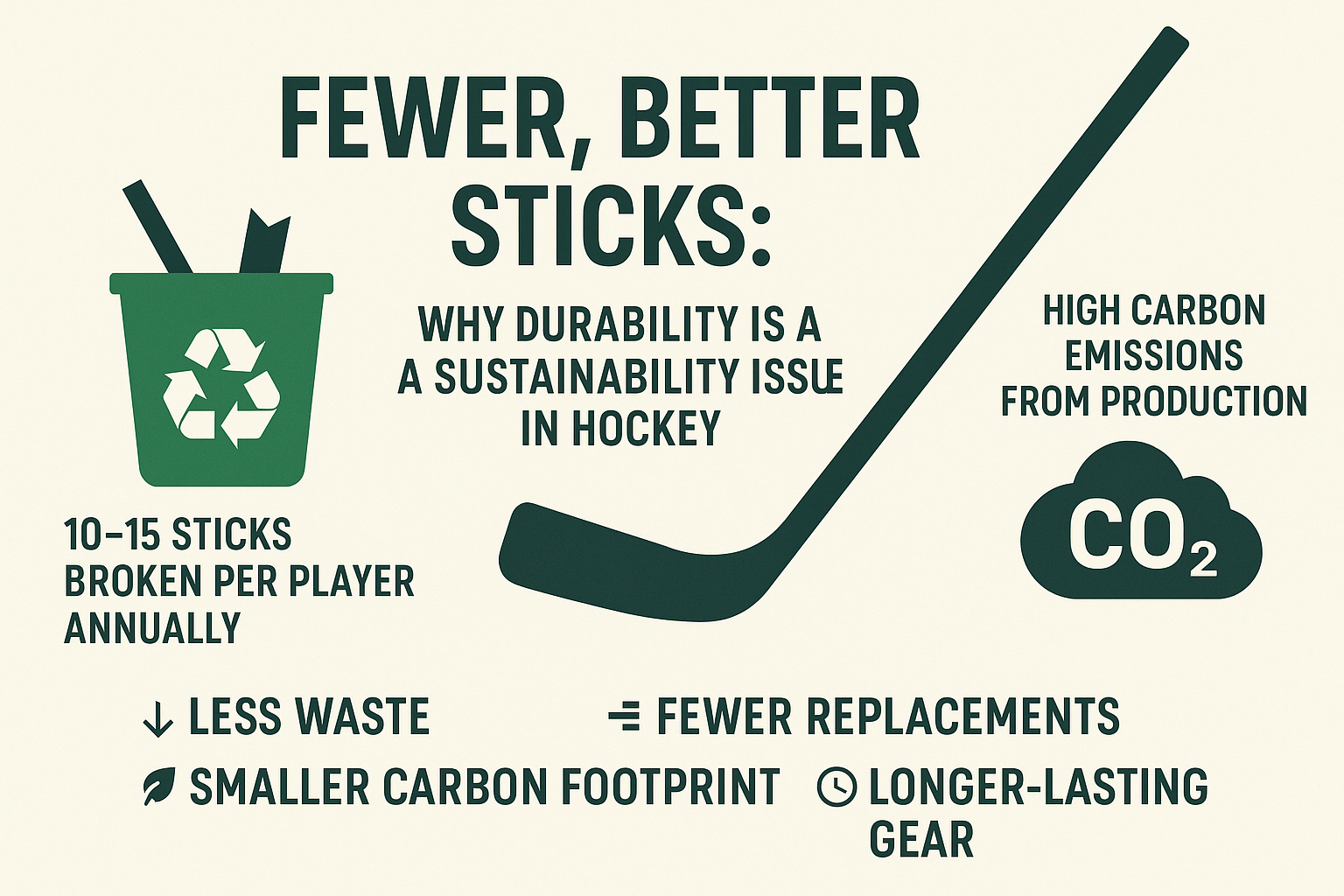Hockey’s Hidden Waste Problem: Why Stick Durability Matters
Let’s face it — hockey isn’t just hard on players. It’s hard on the planet. One of the sport’s biggest sources of waste and emissions? Composite hockey sticks. These high-performance sticks are built for speed and quick release — but not for longevity. The average player breaks multiple sticks per year, contributing to:
- Rising equipment costs
- Unnecessary landfill waste
- Massive carbon emissions from stick production
If we want to make hockey more sustainable and affordable, we need to rethink how sticks are made, how long they last, and how often we replace them.
The Overlooked Drawback of Modern Hockey Sticks
| 🔨 Average Stick Lifespan | ⏳ 4–8 weeks |
|---|---|
| 💸 Average Price | $300–$400 |
| 🔁 Annual Replacements | 10–15 sticks |
| 🗑️ Environmental Result | Thousands of tons of waste and CO₂ |
Modern sticks prioritize lightweight design over durability. Players are stuck in a cycle of breakage, replacement, and waste — and brands are doing little to change that.
Carbon Fiber: Strong on Ice, Harsh on the Planet
The core of every elite stick is carbon fiber — and it comes with a heavy environmental cost.To produce carbon fiber, manufacturers must:
- Heat synthetic polymers (usually PAN) to 2,000–3,000°C
- Use high-energy processes like stabilization, carbonization, and graphitization
- Emit 20–30 kg of CO₂ per kg of fiber
That means a single 450g stick could be responsible for 9–13 kg of CO₂ emissions — before shipping, packaging, or end-of-life disposal. Multiply that across millions of sticks globally, and hockey’s carbon footprint becomes impossible to ignore.
Why This Model Needs to Change
Most hockey brands still rely on:
- High-emission manufacturing
- Non-recyclable materials
- Planned obsolescence
- 30-day warranties that leave players unprotected
The result? Players pay more, sticks break faster, and the planet pays the price.
The Hockey Kollektiv’s Sustainable Solution
At The Hockey Kollektiv, we’re committed to doing things differently — by building fewer, better sticks with longer life spans and lower environmental impact. Here’s how we’re aiming to change the game:
🛠️ Durability-first design
- Reinforced materials that actually last
- Realistic flex and weight balance without compromising performance
⚙️ Low-emission manufacturing
- We’re actively testing production methods that require significantly less heat and energy than traditional carbon fiber processes
- Our goal: reduce CO₂ emissions per stick by at least 50%
♻️ Developing a Functional Recycling Process
- We’re working on the development of a viable recycling system capable of recovering at least 70% of the carbon fibers used in our sticks. This significantly reduces waste and keeps valuable materials in circulation — a major leap toward circular hockey gear manufacturing.
🔄 60+ day warranties
- Because we actually believe our gear should last
- Protection that reflects real-world usage, not loopholes
Next to this action plan we are also exploring 85–90% bio-based composite hockey sticks. These next-gen materials aim to dramatically cut down the use of fossil-based carbon fiber. A future-forward step toward fully sustainable hockey gear.
Less Is More: Why Fewer, Better Sticks Win
| 🟢 Fewer Sticks | 🟢 Lower Cost Over Time |
|---|---|
| 🟢 Less Waste | 🟢 More Durability |
| 🟢 Smaller Carbon Footprint | 🟢 More Trust in the Brand |
We don’t need “more sticks every season.” We need better sticks that last — ones that don’t end up in a landfill (or break after two games).
Final Thoughts: A Call for Smarter Hockey Gear
Durability isn’t just about cost — it’s about sustainability, accountability, and changing the game for future generations. At The Hockey Kollektiv, we’re not just building hockey sticks. We’re building a movement — one that supports players, parents, and the planet.
Want to Join the Movement?
Be the first to access next-gen hockey sticks that perform longer, cost less, and leave a lighter footprint.

 using WordPress and
using WordPress and